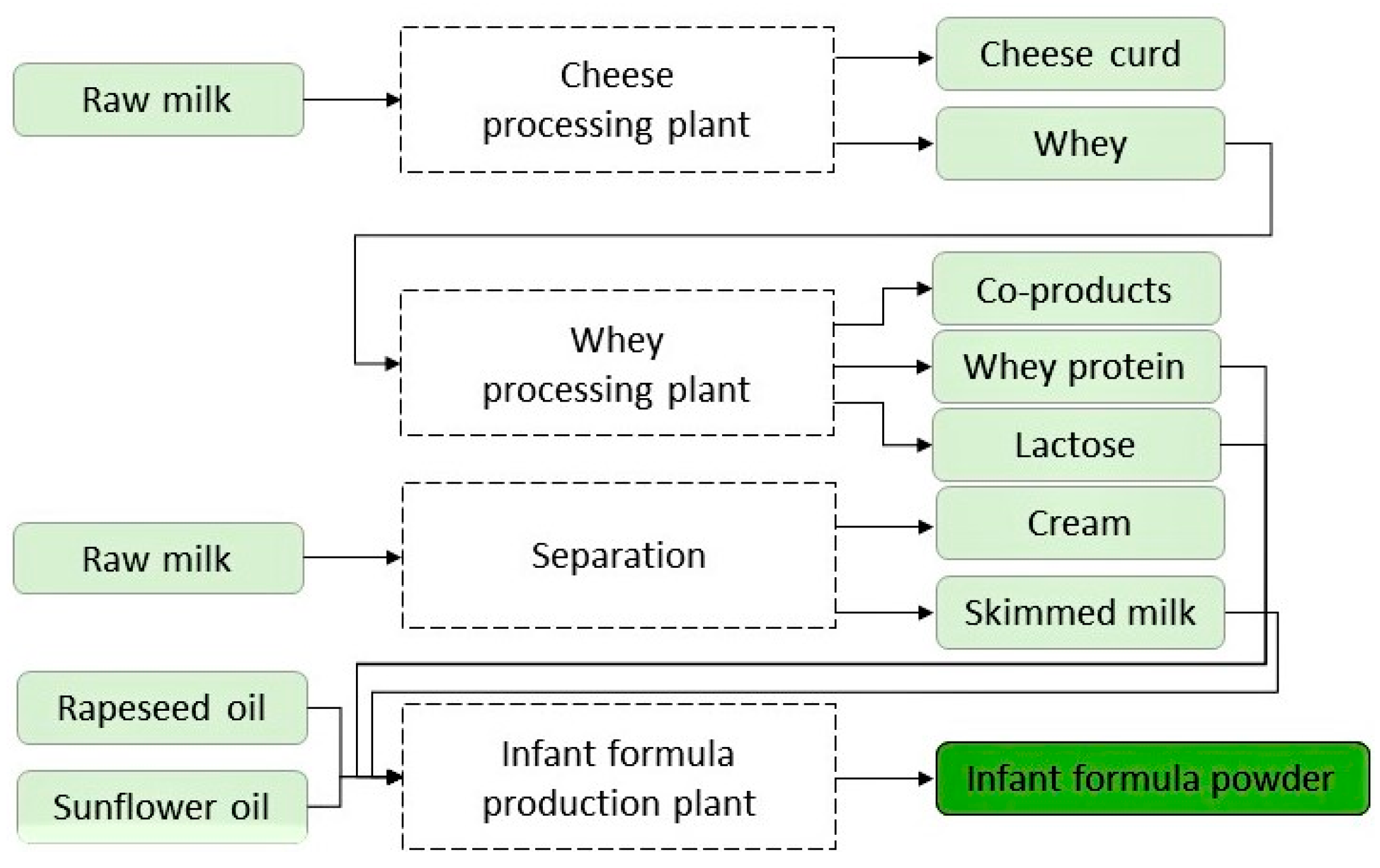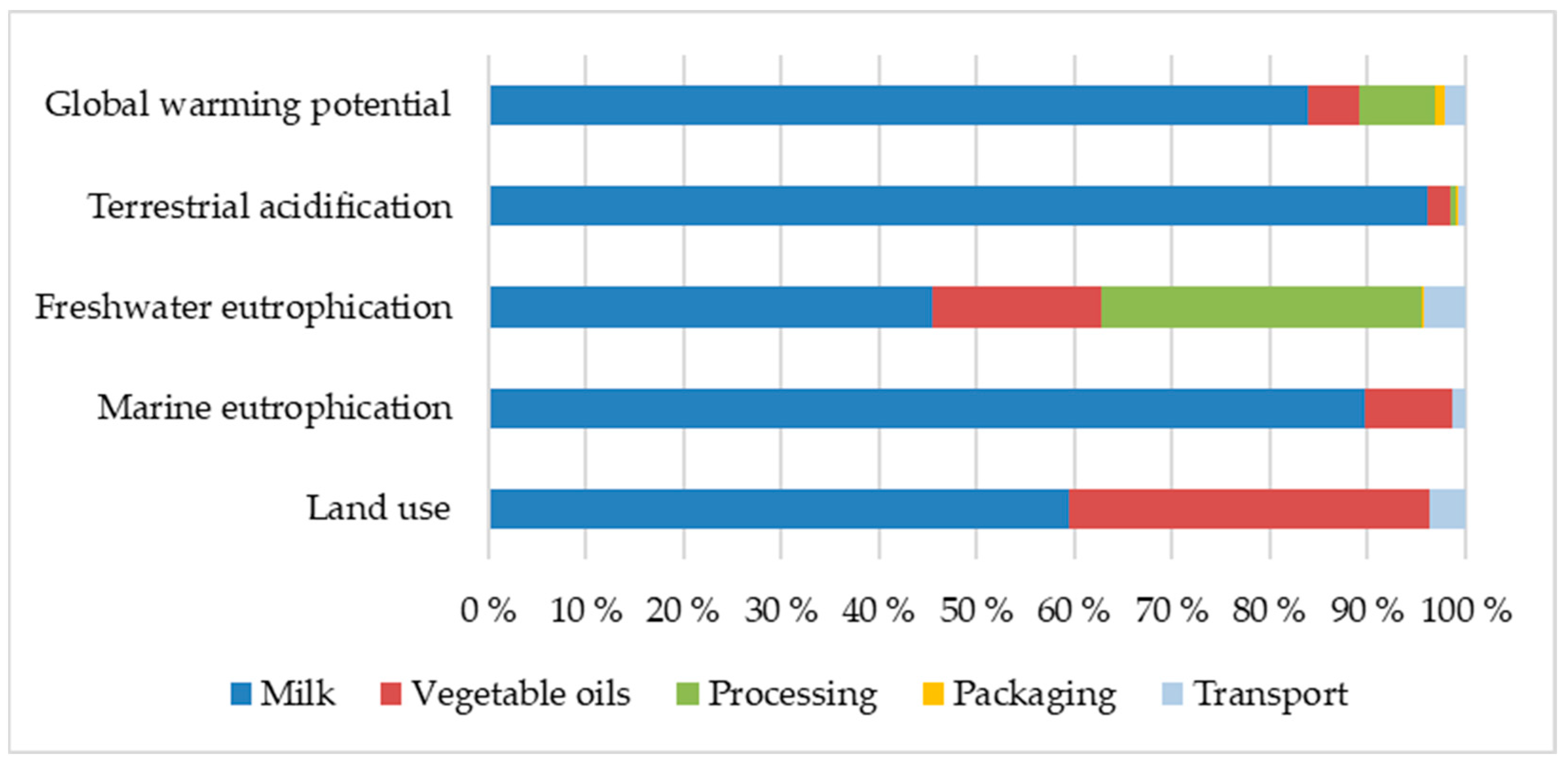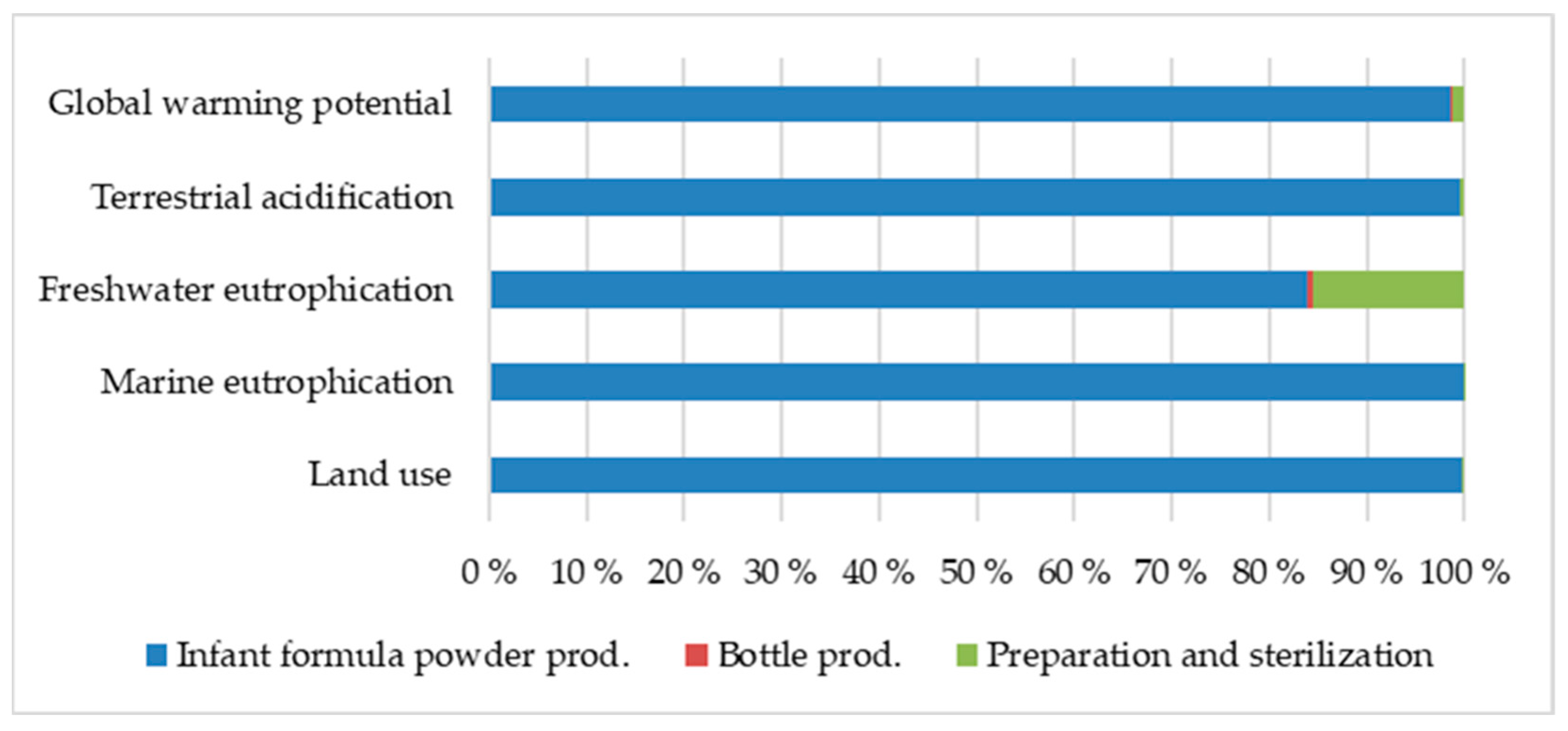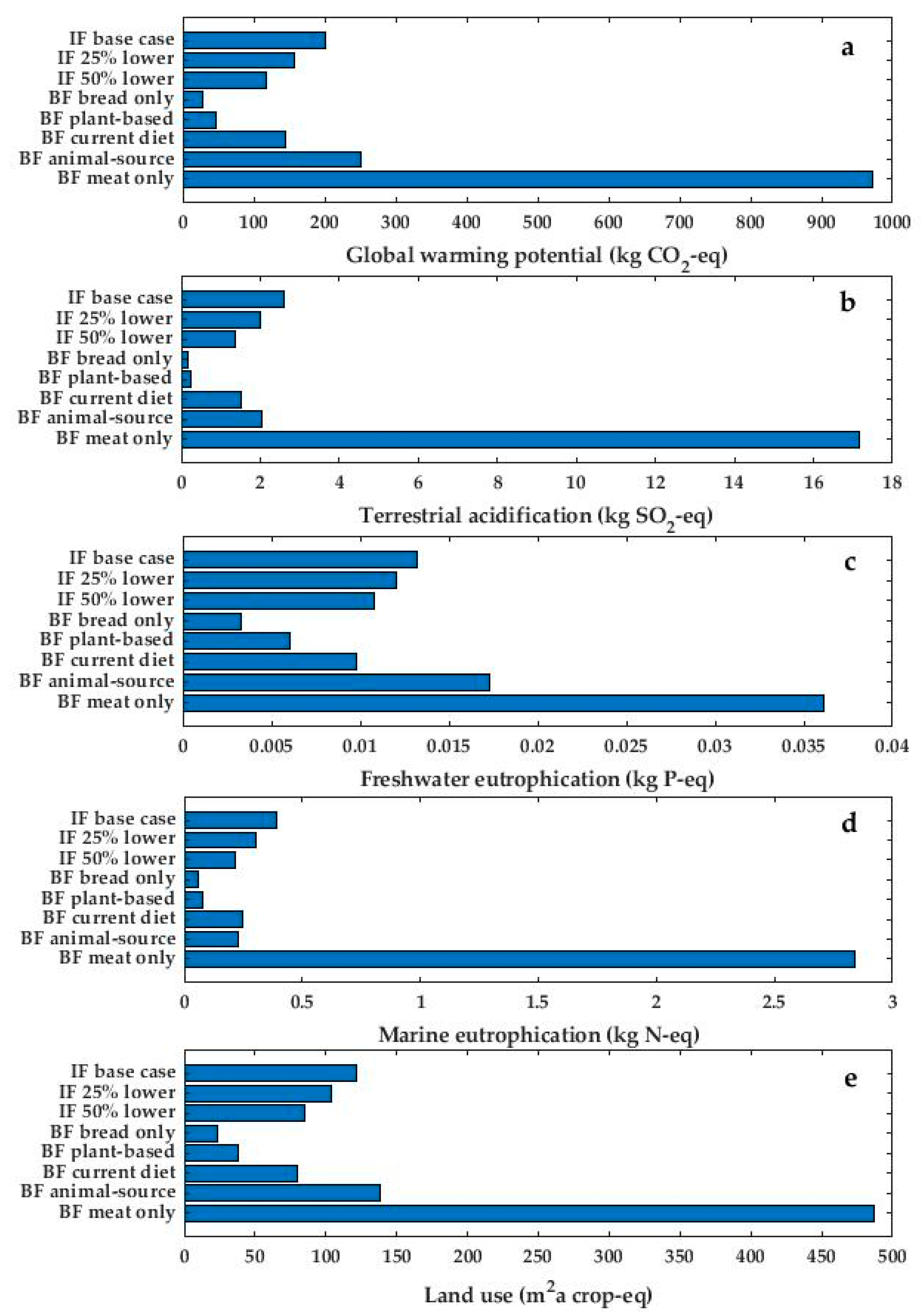Environmental Impact of Feeding with Infant Formula in Comparison with Breastfeeding
Abstract
:1. Introduction
2. Materials and Methods
2.1. Study Set-Up
2.2. Life-Cycle Assessment
2.3. Functional Units and System Boundaries
2.4. Production of Powdered Infant Formula
2.4.1. Infant Formula Recipe and Ingredients
2.4.2. Infant Formula Processing and Packaging
2.4.3. Transport and Distribution
2.5. Consumption of Prepared Infant Formula
2.5.1. Preparation of Infant Formula Ready for Consumption
2.5.2. Production of Feeding Bottles
2.5.3. Waste
2.6. Breastfeeding
2.6.1. Production of Breastmilk
2.6.2. Lactating Mother’s Food Intake
2.7. Feeding with Infant Formula and Breastfeeding for Four Months
2.8. Sensitivity Analysis
3. Results
3.1. Environmental Impact from Infant Formula and Breastmilk
3.2. Environmental Impact from Feeding with Infant Formula Compared to Breastfeeding
3.3. Sensitivity Analysis
4. Discussion
5. Conclusions
Supplementary Materials
Author Contributions
Funding
Institutional Review Board Statement
Informed Consent Statement
Data Availability Statement
Conflicts of Interest
References
- Mameli, C.; Mazzantini, S.; Zuccotti, G.V. Nutrition in the First 1000 Days: The Origin of Childhood Obesity. Int J. Environ. Res. Public Health 2016, 13, 838. [Google Scholar] [CrossRef] [PubMed] [Green Version]
- Victora, C.G.; Bahl, R.; Barros, A.J.; Franca, G.V.; Horton, S.; Krasevec, J.; Murch, S.; Sankar, M.J.; Walker, N.; Rollins, N.C.; et al. Breastfeeding in the 21st century: Epidemiology, mechanisms, and lifelong effect. Lancet 2016, 387, 475–490. [Google Scholar] [CrossRef] [Green Version]
- Grummer-Strawn, L.M.; Rollins, N. Summarising the health effects of breastfeeding. Acta Paediatr. 2015, 104, 1–2. [Google Scholar] [CrossRef] [PubMed] [Green Version]
- Horta, B.L.; Loret de Mola, C.; Victora, C.G. Breastfeeding and intelligence: A systematic review and meta-analysis. Acta Paediatr. 2015, 104, 14–19. [Google Scholar] [CrossRef] [PubMed]
- Horta, B.L.; Loret de Mola, C.; Victora, C.G. Long-term consequences of breastfeeding on cholesterol, obesity, systolic blood pressure and type 2 diabetes: A systematic review and meta-analysis. Acta Paediatr. 2015, 104, 30–37. [Google Scholar] [CrossRef] [PubMed]
- Hornell, A.; Lagstrom, H.; Lande, B.; Thorsdottir, I. Breastfeeding, introduction of other foods and effects on health: A systematic literature review for the 5th Nordic Nutrition Recommendations. Food Nutr. Res. 2013, 57, 20823. [Google Scholar] [CrossRef] [Green Version]
- Kramer, M.S.; Kakuma, R. Optimal duration of exclusive breastfeeding. Cochrane Database Syst. Rev. 2012, 8, CD003517. [Google Scholar] [CrossRef]
- Helsedirektoratet. Nasjonal Faglig Retningslinje for Spedbarnsernæring. Available online: https://www.helsedirektoratet.no/retningslinjer/spedbarnsernaering (accessed on 22 November 2021).
- Myhre, J.B.; Andersen, L.F.; Kristiansen, A.L. Landsomfattende Undersøkelse av Kostholdet Blant Spedbarn i Norge, 6 Måneder; Folkehelseinstituttet: Oslo, Norway, 2020. [Google Scholar]
- Baker, P.; Smith, J.; Salmon, L.; Friel, S.; Kent, G.; Iellamo, A.; Dadhich, J.P.; Renfrew, M.J. Global trends and patterns of commercial milk-based formula sales: Is an unprecedented infant and young child feeding transition underway? Public Health Nutr. 2016, 19, 2540–2550. [Google Scholar] [CrossRef] [Green Version]
- Baker, P.; Santos, T.; Neves, P.A.; Machado, P.; Smith, J.; Piwoz, E.; Barros, A.J.D.; Victora, C.G.; McCoy, D. First-food systems transformations and the ultra-processing of infant and young child diets: The determinants, dynamics and consequences of the global rise in commercial milk formula consumption. Matern. Child Nutr. 2021, 17, e13097. [Google Scholar] [CrossRef]
- Pope, D.H.; Karlsson, J.O.; Baker, P.; McCoy, D. Examining the Environmental Impacts of the Dairy and Baby Food Industries: Are First-Food Systems a Crucial Missing Part of the Healthy and Sustainable Food Systems Agenda Now Underway? Int. J. Environ. Res. Public Health 2021, 18, 12678. [Google Scholar] [CrossRef]
- Dadhich, J.P.; Smith, J.P.; Iellamo, A.; Suleiman, A. Climate Change and Infant Nutrition: Estimates of Greenhouse Gas Emissions from Milk Formula Sold in Selected Asia Pacific Countries. J. Hum. Lact. 2021, 37, 314–322. [Google Scholar] [CrossRef] [PubMed]
- Smith, J.P. A commentary on the carbon footprint of milk formula: Harms to planetary health and policy implications. Int. Breastfeed. J. 2019, 14, 49. [Google Scholar] [CrossRef] [PubMed] [Green Version]
- Joffe, N.; Webster, F.; Shenker, N. Support for breastfeeding is an environmental imperative. BMJ 2019, 367, l5646. [Google Scholar] [CrossRef] [PubMed]
- Cadwell, K.; Blair, A.; Turner-Maffei, C.; Gabel, M.; Brimdyr, K. Powdered Baby Formula Sold in North America: Assessing the Environmental Impact. Breastfeed. Med. 2020, 15, 671–679. [Google Scholar] [CrossRef]
- United Nations. United Nations Decade of Action on Nutrition. Available online: https://www.un.org/nutrition/ (accessed on 14 February 2022).
- United Nations. United Nations Food Systems Summit 2021. Available online: https://www.un.org/en/food-systems-summit (accessed on 14 February 2022).
- Willett, W.; Rockstrom, J.; Loken, B.; Springmann, M.; Lang, T.; Vermeulen, S.; Garnett, T.; Tilman, D.; DeClerck, F.; Wood, A.; et al. Food in the Anthropocene: The EAT-Lancet Commission on healthy diets from sustainable food systems. Lancet 2019, 393, 447–492. [Google Scholar] [CrossRef]
- Swinburn, B.A.; Kraak, V.I.; Allender, S.; Atkins, V.J.; Baker, P.I.; Bogard, J.R.; Brinsden, H.; Calvillo, A.; De Schutter, O.; Devarajan, R.; et al. The Global Syndemic of Obesity, Undernutrition, and Climate Change: The Lancet Commission report. Lancet 2019, 393, 791–846. [Google Scholar] [CrossRef]
- High Level Panel of Experts on Food Security and Nutrition (HLPE). Food Security and Nutrition: Building a Global Narrative towards 2030: A Report by the High Level Panel of Experts on Food Security and Nutrition of the Committee on World Food Security; HLPE: Rome, Italy, 2020. [Google Scholar]
- Intergovernmental Panel on Climate Change (IPCC). Climate Change 2022: Impacts, Adaptation, and Vulnerability. Contribution of Working Group II to the Sixth Assessment Report of the Intergovernmental Panel on Climate Change; Cambridge University Press: Cambridge, UK, 2022. [Google Scholar]
- Monteiro, C.A.; Cannon, G.; Lawrence, M.; Costa Louzada, M.L.; Machado, P. Ultra-Processed Foods, Diet Quality, and Health Using the NOVA Classification System; FAO: Rome, Italy, 2019. [Google Scholar]
- Baker, P.; Machado, P.; Santos, T.; Sievert, K.; Backholer, K.; Hadjikakou, M.; Russell, C.; Huse, O.; Bell, C.; Scrinis, G.; et al. Ultra-processed foods and the nutrition transition: Global, regional and national trends, food systems transformations and political economy drivers. Obes. Rev. 2020, 21, e13126. [Google Scholar] [CrossRef]
- Martin, C.R.; Ling, P.R.; Blackburn, G.L. Review of Infant Feeding: Key Features of Breast Milk and Infant Formula. Nutrients 2016, 8, 279. [Google Scholar] [CrossRef] [Green Version]
- Coriolis. Understanding the Infant Formula Value Chain; Coriolis: Auckland, New Zealand, 2014. [Google Scholar]
- Karlsson, J.O.; Garnett, T.; Rollins, N.C.; Roos, E. The carbon footprint of breastmilk substitutes in comparison with breastfeeding. J. Clean Prod. 2019, 222, 436–445. [Google Scholar] [CrossRef]
- Amonkar, Y.; Chowdhury, N.; Song, Y.; Wu, J.S.; Vaidya, P.; Meinrenken, C.J. Life Cycle GHG Emission Comparison of Infant Nursing Using Breast Milk Versus Formula. J. Environ. Account. Manag. 2019, 7, 59–72. [Google Scholar] [CrossRef]
- ISO 14040; Environmental Management. Life Cycle Assessment. Principles and Framework. ISO: Geneva, Switzerland, 2006.
- ISO 14044; Environmental Management. Life Cycle Assessment. Requirements and Guidelines. ISO: Geneva, Switzerland, 2006.
- Huijbregts, M.A.J.; Steinmann, Z.J.; Elshout, P.M.F.; Stam, G.; Verones, F.; Vieira, M.D.M.; Hollander, A.; Zijp, M.; van Zelm, R. ReCiPe 2016 v1.1 A Harmonized Life Cycle Impact Assessment Method at Midpoint and Endpoint Level Report 1: Characterization. RIVM Report 2016-0104a; National Institute for Public Health and the Environment RIVM: Bilthoven, The Netherlands, 2017.
- Poore, J.; Nemecek, T. Reducing food's environmental impacts through producers and consumers. Science 2018, 360, 987–992. [Google Scholar] [CrossRef] [PubMed] [Green Version]
- Steffen, W.; Richardson, K.; Rockstrom, J.; Cornell, S.E.; Fetzer, I.; Bennett, E.M.; Biggs, R.; Carpenter, S.R.; de Vries, W.; de Wit, C.A.; et al. Planetary boundaries: Guiding human development on a changing planet. Science 2015, 347, 1259855. [Google Scholar] [CrossRef] [PubMed] [Green Version]
- Blonk Consultants. Agri-Footprint 5.0. Part 2: Description of Data; Blonk Consultants: Gouda, The Netherlands, 2019. [Google Scholar]
- Blonk Consultants. Agri-Footprint 5.0. Part 1: Methodology and Basic Principles; Blonk Consultants: Gouda, The Netherlands, 2019. [Google Scholar]
- Nemecek, T.; Heil, A.; Huguenin, O.; Meier, S.; Erzinger, S.; Blaser, S.; Dux, D.; Zimmermann, A. Life Cycle Inventories of Agricultural Production Systems; Swiss Centre for Life Cycle Inventories: Dübendorf, Switzerland, 2004. [Google Scholar]
- Moreno Ruiz, E.L.; Valsasina, L.; Fitzgerald, D.; Brunner, F.; Vadenbo, C.; Bauer, C.; Bourgault, G.; Symeoidis, A.; Wernet, G. Documentation of Changes Implemented in the Ecoinvent Database v.3.4; Ecoinvent: Zürich, Switzerland, 2016. [Google Scholar]
- RIVM. Milieubelasting van Voedingsmiddelen. Available online: https://www.rivm.nl/voedsel-en-voeding/duurzaam-voedsel/database-milieubelasting-voedingsmiddelen (accessed on 29 March 2021).
- GEA. Nutritional Formula; GEA: Soeberg, Denmark, 2019. [Google Scholar]
- Food and Agriculture Organization of the United Nations (FAO); World Health Organization (WHO). Codex Alimentarius. Standard for Infant Formula and Formulas for Special Medical Purposes Intended for Infants; FAO: Rome, Italy, 1981.
- Nestlé Norge. Nestlé Barnemat NAN PRO 1, 800g. Available online: www.nestlebarnemat.no/produkt/nan-pro-1-800g (accessed on 5 April 2021).
- Gustavsson, J.; Cederber, C.; Sonesson, U.; Van Otterdijk, R.; Meybeck, A. Food Losses and Food Waste—Extent, Causes and Prevention; Food and Agriculture Organization of the United Nations (FAO): Rome, Italy, 2011. [Google Scholar]
- Tietze, L.; (Nestlé Danmark, Copenhagen, Denmark). Personal communication, 9 April 2021.
- Tietze, L.; (Nestlé Danmark, Copenhagen, Denmark). Personal communication, 6 April 2021.
- Food and Agriculture Organization of the United Nations (FAO); World Health Organization (WHO); United Nations University (UNU). Human Energy Requirements. In Report of a Joint FAO/WHO/UNU Expert Consultation; FAO: Rome, Italy, 2004. [Google Scholar]
- Oberascher, C.; Stamminger, R.; Pakula, C. Energy efficiency in daily food preparation. Int. J. Consum. Stud. 2011, 35, 201–211. [Google Scholar] [CrossRef]
- Stensgård, A.E.; Presterud, K.; Callewaert, P. Matsvinn i Norge-Rapportering av Nøkkeltall 2015–2019; NORSUS: Kråkerøy, Norway, 2020. [Google Scholar]
- Nordic Council of Ministers. Nordic Nutrition Recommendations 2012: Integrating Nutrition and Physical Activity; Nordisk Ministerråd: Copenhagen, Denmark, 2014. [Google Scholar]
- Butte, N.F.; King, J.C. Energy requirements during pregnancy and lactation. Public Health Nutr. 2005, 8, 1010–1027. [Google Scholar] [CrossRef] [PubMed] [Green Version]
- Totland, T.H.; Melnæs, B.K.; Lundberg-Hallén, N.; Helland-Kigen, K.M.; Lund-Blix, N.A.; Myhre, J.B.; Wetting Johansen, A.M.; Løken, E.B.; Andersen, L.F. Norkost 3. En Landsomfattende Kostholdsundersøkelse Blant Menn og Kvinner i Norge i Alderen 18–70 år, 2010–2011; Norwegian Directorate of Health: Oslo, Norway, 2012.
- Bakken, A.K.; Daugstad, K.; Johansen, A.; Hjelkrem, A.G.R.; Fystro, G.; Stromman, A.H.; Korsaeth, A. Environmental impacts along intensity gradients in Norwegian dairy production as evaluated by life cycle assessments. Agric. Syst. 2017, 158, 50–60. [Google Scholar] [CrossRef]
- Hagemann, M.; Hemme, T.; Ndambi, A.; Alqaisi, O.; Sultana, M.N. Benchmarking of greenhouse gas emissions of bovine milk production systems for 38 countries. Anim. Feed Sci. Technol. 2011, 166–167, 46–58. [Google Scholar] [CrossRef]
- Notarnicola, B.; Tassielli, G.; Renzulli, P.A.; Castellani, V.; Sala, S. Environmental impacts of food consumption in Europe. J. Clean. Prod. 2017, 140, 753–765. [Google Scholar] [CrossRef]
- Helsedirektoratet. Spedbarnsmat og Amming: Morsmelkerstatning. Available online: https://www.helsenorge.no/spedbarn/spedbarnsmat-og-amming/morsmelkerstatning-videoer/ (accessed on 21 February 2022).
- UNICEF UK. UNICEF UK Baby-Friendly Initiative. In Guide to Bottle Feeding; UNICEF UK: London, UK, 2021. [Google Scholar]
- Engvik, M.; Pettersen, M. SSB Analyser 2021/14. Lengst Pappaperm Blant Lærere, Men Langt Fra en Likedeling; Publisher: Oslo, Norway, 2021. [Google Scholar]
- Becker, G.; Ryan-Fogarty, Y. Reliance on Pumped Mother’s Milk Has an Environmental Impact. Children 2016, 3, 14. [Google Scholar] [CrossRef] [Green Version]




| Ingredients | % of Solid Mass |
|---|---|
| Skimmed milk | 15 |
| Whey protein concentrate | 10 |
| Lactose | 50 |
| Vegetable oils | 25 |
| Impact Category | Unit | 1 kg Infant Formula Powder |
|---|---|---|
| Global warming potential | kg CO2-eq | 12.65 |
| Terrestrial acidification | kg SO2-eq | 1.17 × 10−1 |
| Freshwater eutrophication | kg P-eq | 7.14 × 10−4 |
| Marine eutrophication | kg N-eq | 2.53 × 10−2 |
| Land use | m2a crop-eq | 7.82 |
| Impact Category | Unit | 1 kg Infant Formula | 1 kg Breastmilk | Difference between Breastmilk and Infant Formula * |
|---|---|---|---|---|
| Global warming potential | kg CO2-eq | 2.02 | 1.58 | 0.44 (28%) |
| Terrestrial acidification | kg SO2-eq | 2.64 × 10−2 | 1.65 × 10−2 | 0.99 × 10−2 (60%) |
| Freshwater eutrophication | kg P-eq | 1.33 × 10−4 | 1.07 × 10−4 | 0.26 × 10−4 (24%) |
| Marine eutrophication | kg N-eq | 3.97 × 10−3 | 2.68 × 10−3 | 1.29 × 10−3 (48%) |
| Land use | m2a crop-eq | 1.23 | 0.87 | 0.36 (41%) |
| Impact Category | Unit | 4 Months Feeding with Infant Formula | 4 Months Breastfeeding | Difference between Breastfeeding and Infant Formula Feeding * |
|---|---|---|---|---|
| Global warming potential | kg CO2-eq | 200 | 145 | 55 (38%) |
| Terrestrial acidification | kg SO2-eq | 2.61 | 1.52 | 1.09 (72%) |
| Freshwater eutrophication | kg P-eq | 1.32 × 10−2 | 0.98 × 10−2 | 0.34 × 10−2 (35%) |
| Marine eutrophication | kg N-eq | 3.93 × 10−1 | 2.47 × 10−1 | 1.46 × 10−1 (59%) |
| Land use | m2a crop-eq | 122 | 80 | 42 (53%) |
Publisher’s Note: MDPI stays neutral with regard to jurisdictional claims in published maps and institutional affiliations. |
© 2022 by the authors. Licensee MDPI, Basel, Switzerland. This article is an open access article distributed under the terms and conditions of the Creative Commons Attribution (CC BY) license (https://creativecommons.org/licenses/by/4.0/).
Share and Cite
Andresen, E.C.; Hjelkrem, A.-G.R.; Bakken, A.K.; Andersen, L.F. Environmental Impact of Feeding with Infant Formula in Comparison with Breastfeeding. Int. J. Environ. Res. Public Health 2022, 19, 6397. https://doi.org/10.3390/ijerph19116397
Andresen EC, Hjelkrem A-GR, Bakken AK, Andersen LF. Environmental Impact of Feeding with Infant Formula in Comparison with Breastfeeding. International Journal of Environmental Research and Public Health. 2022; 19(11):6397. https://doi.org/10.3390/ijerph19116397
Chicago/Turabian StyleAndresen, Ellen Cecilie, Anne-Grete Roer Hjelkrem, Anne Kjersti Bakken, and Lene Frost Andersen. 2022. "Environmental Impact of Feeding with Infant Formula in Comparison with Breastfeeding" International Journal of Environmental Research and Public Health 19, no. 11: 6397. https://doi.org/10.3390/ijerph19116397
APA StyleAndresen, E. C., Hjelkrem, A.-G. R., Bakken, A. K., & Andersen, L. F. (2022). Environmental Impact of Feeding with Infant Formula in Comparison with Breastfeeding. International Journal of Environmental Research and Public Health, 19(11), 6397. https://doi.org/10.3390/ijerph19116397






